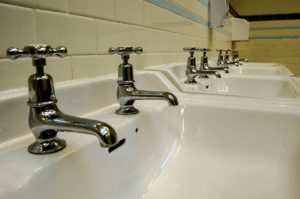With many employers now offering hybrid working opportunities, Craig Morning, Senior Consultant at Water Hygiene Centre, investigates why water quality needs to be considered due to the reduced capacity of many properties.
 As we see the light at the end of the tunnel getting closer and the lockdown restrictions have eased, now would be a good time to consider how our offices and workplaces will be used in the future.
As we see the light at the end of the tunnel getting closer and the lockdown restrictions have eased, now would be a good time to consider how our offices and workplaces will be used in the future.
Many business and employees have found that being able to work from home has been effective and recent studies have shown that many do not want to return to working full time in their old work places. It appears that businesses are willing to discuss this hybrid / blended working where employees will spend a portion of their time working from home and the rest working from their existing sites.
But have these businesses considered the effect this will have on water hygiene? In this article, I will highlight some of the areas of concern and offer some insight into ways to mitigate any additional risks identified.
Firstly, we must remember that in the majority of buildings in the UK we use some basic precautions to help control the growth of waterborne pathogens including legionella risk.
Namely we ensure:
- Water systems are designed to meet the needs of the building users.
- That these systems are constructed using only approved materials.
- That the hot water is kept hot.
- The cold water is kept cold.
- That the assets are used regularly*.
- That everything is kept clean.
- That pieces of plant and equipment are kept well maintained.
 So, if we now think about how hybrid, or blended, working will effect this, we can see that the very first area we need to reconsider is the fundamental design of the water systems on site. Where a water system has been designed to supply toilets and washing facilities to 500 people in an office block and we now only have 150 using the system each day we can see a problem is going to develop. Where Cold Water Storage Tanks have been installed these should hold a maximum of 24* hours use of water based on normal use, but now many of the outlets will not be used by as many people and we are likely to be using a lot less water. What evidence do you have to show that you have given consideration to the amount of cold water you store at site? If you have made changes to the water systems have you commissioned a new water hygiene risk assessment as would be required under ACoP L8 Paragraphs 32 and 47.
So, if we now think about how hybrid, or blended, working will effect this, we can see that the very first area we need to reconsider is the fundamental design of the water systems on site. Where a water system has been designed to supply toilets and washing facilities to 500 people in an office block and we now only have 150 using the system each day we can see a problem is going to develop. Where Cold Water Storage Tanks have been installed these should hold a maximum of 24* hours use of water based on normal use, but now many of the outlets will not be used by as many people and we are likely to be using a lot less water. What evidence do you have to show that you have given consideration to the amount of cold water you store at site? If you have made changes to the water systems have you commissioned a new water hygiene risk assessment as would be required under ACoP L8 Paragraphs 32 and 47.
Following on from that [and very closely linked to it] we would review the usage of the outlets in the building. Where we suspect that outlets are not being used regularly we should first consider permanently removing these along with all associated pipework to eliminate any risks. Where it is identified that these will be intermittently used [possibly seasonal or kept for emergency situations] a suitable flushing regime should be instigated. The frequency and method for carrying out this task needs to be considered alongside the water hygiene risk assessment and the type of people likely to use the water system in the future. What evidence can you produce to show that you have considered or reviewed the usage of the outlets fitted to each water system? Maybe you have a plan in place to review this once all colleagues have settled into their new working patterns, in this case you will still need to consider the risks posed whilst you carry out this investigatory work.
If we next think about water temperature, under-occupied and underutilised buildings [especially those without enhanced flushing regimes] will see more occasions where water temperatures will be outside the recommended ranges for controlling the growth of waterborne bacteria, including Legionella risk. On cold water systems you may see additional heat gain and cold water temperatures consistently above 20°C. If this is the case, then the mitigation you have put in place in the first two areas above has not been effective and a further review will be required. For hot water systems, especially those that do NOT have circulating systems, a reduction in usage will lead to greater time periods where the water is allowed to cool down between usages. Overtime this will lead to water samples results returning adverse effects and possibly people becoming unwell. What is your process for reviewing out of specification results identified during routine monitoring and maintenance?
The above steps are some brief thoughts and suggestions on the way that you can provide a safe environment [from a water quality perspective] to those returning to the workplace. If you are confident that your organisation can satisfy the requests of any auditors and prove that changes have at least been considered, then you are in a good place. If, however, you have identified that there is work to do then now is the time to start this process.
* There are differences between healthcare and non-healthcare regulations.
This article was originally published by Water Hygiene Centre.
The Safety Conversation Podcast: Listen now!
The Safety Conversation with SHP (previously the Safety and Health Podcast) aims to bring you the latest news, insights and legislation updates in the form of interviews, discussions and panel debates from leading figures within the profession.
Find us on Apple Podcasts, Spotify and Google Podcasts, subscribe and join the conversation today!

 As we see the light at the end of the tunnel getting closer and the
As we see the light at the end of the tunnel getting closer and the  So, if we now think about how hybrid, or blended, working will effect this, we can see that the very first area we need to reconsider is the fundamental design of the water systems on site. Where a water system has been designed to supply toilets and washing facilities to 500 people in an office block and we now only have 150 using the system each day we can see a problem is going to develop. Where Cold Water Storage Tanks have been installed these should hold a maximum of 24* hours use of water based on normal use, but now many of the outlets will not be used by as many people and we are likely to be using a lot less water. What evidence do you have to show that you have given consideration to the amount of cold water you store at site? If you have made changes to the water systems have you commissioned a new
So, if we now think about how hybrid, or blended, working will effect this, we can see that the very first area we need to reconsider is the fundamental design of the water systems on site. Where a water system has been designed to supply toilets and washing facilities to 500 people in an office block and we now only have 150 using the system each day we can see a problem is going to develop. Where Cold Water Storage Tanks have been installed these should hold a maximum of 24* hours use of water based on normal use, but now many of the outlets will not be used by as many people and we are likely to be using a lot less water. What evidence do you have to show that you have given consideration to the amount of cold water you store at site? If you have made changes to the water systems have you commissioned a new 